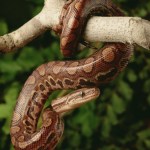grip
Today was the final day of the meeting.
Dr. Joe Thompson (Franklin and Marshall College) spoke about oblique striated muscles, which get their name from the diagonal pattern formed by the location of the Z-lines. This type of muscle is common among cephalopods, nematodes, tunicates, molluscs, etc.
Dr. John Whiteman (University of Wyoming) gave a fascinating talk about polar bears and whether hunting on the shore as compared to the sea ice helped the animals replenish stores after hibernation or fasting as well as how foraging patterns affected activity levels.
Dr. Michael Butcher (…
Image of a green tree python from www.kids.britannica.com J.H. Pete Carmichael—The Image Bank/Getty Images
Dr. Greg Byrnes (Siena College, Loudonville, NY) and Dr. Bruce Jayne (University of Cincinnati, OH) discovered that snakes use more force than is necessary to support their weight when climbing. To climb, snakes rely on friction and repeatedly contract and extend their bodies, a process called concertina locomotion. To study the forces generated by snakes during this type of locomotion, the researchers constructed a vertical cylinder that was covered with textured tennis racket…
Many plants depend so heavily on visits from bees that they go to great lengths to attract them, using brightly coloured flowers baited with sweet nectar. But some of their tricks are much subtler and are designed not to attract six-legged visitors, but to make their stay more convenient.
The majority of flowering plants have evolved special conical cells that line the surface of their petals and are found nowhere else. These cells provide the flower with a rougher texture that is indistinguishable to human fingers, but that provide just enough purchase for the claws of landing insects.…
